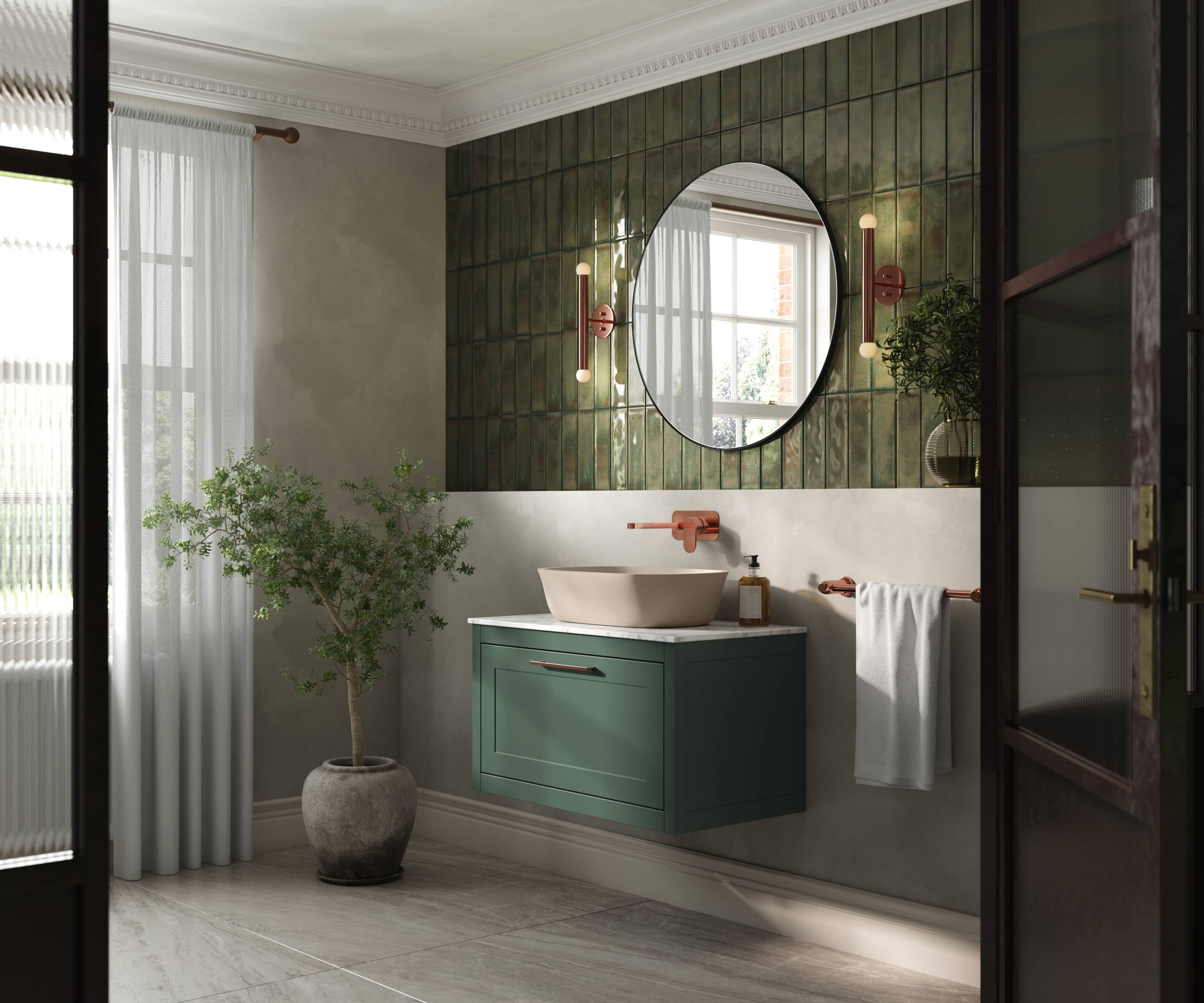Can eco friendly bathrooms be stylish and sustainable? Experts say yes and share their must-have choices
If an eco friendly bathroom sounds devoid of style, you need to think again say the experts. It can be just as stylish as a standard one – and longer lasting

Sustainability has become a driving force in homebuilding and renovating trends, with eco friendly bathrooms a prime example of how times have changed.
While eco friendly bathrooms were once considered the territory of compostable toilets and recycled water systems, developments in design and technology mean it's not longer necessary to sacrifice style in favour of doing the right thing.
Instead, while water and energy saving measures will always form part of any eco friendly bathroom design, it's also about picking your fixtures and fittings wisely so that all the elements of your bathroom design are chosen with a conscience.
What defines an eco friendly bathroom design?
One thing our experts all agree on is that while there's a variety of elements involved in choosing an eco friendly bathroom design, one of the key factors is an ever-growing emphasis on longevity.
"An eco-friendly bathroom is of course designed with sustainability in mind, using products and features such as energy efficient LED lighting, water saving fixtures and durable designs," says Jorge Hernandez, head of product design at Crosswater, "but most importantly we see a ‘buy-once’ mentality forming part of the decision making process. Choosing products that will last, not only helps to reduce waste but also saves on costs and overconsumption."
However, in order to understand what can make for an an eco friendly bathroom, we're breaking down down all the different elements to help you make more informed decisions when finalising your bathroom design ideas.


Jorge is passionate about the way design shapes our interaction with the world. He believes designing for the bathroom, a seemingly utilitarian space, is an important necessity that offers the designer plenty of tools to play with including material, colour, and experience.
Water and energy saving options in an eco friendly bathroom
Choosing walk in shower ideas over installing a bath has long been known as one of the best ways of saving water in the bathroom, but if you're a fan of a rainfall shower, you'll also know how much water travels through the shower head. And, if you have a young family, you'll also know how much having a bath is essential.
But, despite rising water bills, it seems our use of water shows no signs of decreasing, says Louise Ashdown, head of design at West One Bathrooms.
"With the average amount of water consumption increasing and many consumers seemingly unaware of the volume of water used throughout the home, particularly in the bathroom, our water consumption in the Western world is still on the increase.
"For instance, taking regular baths is the biggest water usage in households – on average it takes 115 litres of water to fill up a bath. Whilst taking a shower, you use on average 50 litres of water," says Louise Ashdown. "By designing a bathroom that is sustainable, you could therefore considerably reduce energy and water consumption.
But how? The good news is there are an increasing number of options available and more in the pipeline.
"Manufacturers are increasingly working on developing sustainable products," says Louise Ashdown. "Water saving devices such as low flow taps and showers, as well as dual flush toilets are relatively inexpensive and effective.
"An effective and sustainable way to save water is by introducing aerators to taps and shower heads. It doesn’t compromise water pressure, it simply fills the water with tiny air bubbles by behaving a bit like a sieve, sorting the water into separate streams and mixing it with air," she explains.
"This results in the same pressure, but at a reduced water flow. Aerators don't require any major work or plumbing experience and anyone can fit them easily. For instance, older taps flow at a rate of around 15 litres of water per minute, but an aerator can reduce that to as little at 6 litres."
Shop these eco friendly bathroom products

Add an aerator to your bathroom taps with this easy to fit pack of five from Amazon

Louise is Head of Design at West One Bathrooms, having worked in the industry for over 18 years. At West One Bathrooms, one of the UK’s premium and luxury bathroom retailers, she heads up the design and creative teams, overseeing all the bathroom projects, as well as sourcing the latest products. Her passion for bathroom design is unparallel.
Making your bath more eco efficient
While choosing a smaller bath will naturally reduce the amount of water you use, Barry Cutchie, design director at BC Designs shares a clever trick for keeping the overall dimensions of your bathtub the same, but reducing the amount of water it contains.
“While there’s nothing nicer than relaxing in a deep bath, water usage from bathing can soon add up, with a standard 180L capacity bath generally filled with around 80L of water," he explains.
"There is a way around this though. Buying a bath without a pre-drilled overflow means you tailor the overflow to your needs – by having it drilled lower, you will only be able to have baths of a certain depth, removing the temptation to top it right up.”


Barrie Cutchie founded British bathroom brand, BC Designs in 1999. He is an award-winning bathroom designer who has been at the forefront of the industry for over 30 years.
Choose eco-friendly materials
“While using less water and energy are a great way to minimise your impact on the planet, when you’re investing in a luxury bathroom, you can also make informed choices about the materials you use," says Barrie Cutchie.
"For example, pick locally-made, recyclable or sustainable fittings and fixtures. Another good place to start is by choosing pieces made from materials, that won’t ultimately end up in landfill. This predominantly means avoiding plastic," he adds.
Some manufacturers are also taking this one step further, such as the Kohler WasteLAB, Louise Ashdown tell us.
"Looking at the life cycle of products from an alternative angle, what if waste bound for the landfill had hidden value?" she says. "The innovative Kohler WasteLAB looks to nature as a model for sustainable processes – within nature’s cycles of growth and decay, waste simply doesn’t exist. Through this exploration, they are able to take a step towards building a sustainable circular economy, one in which we reuse, rethink and repurpose waste streams to create beautiful, thoughtful products.
"Recently, they launched the first of these products," she explains, which is the Crackle Collection, tiles being made in partnership with Ann Sacks®.
"The Crackle Collection tiles are handmade by WasteLAB artisans and decorated with a dimensional visual effect achieved with a unique glaze designed to pool and break over the textured surface during firing," says Louise. "Tapping into current paint trends, the Crackle Collection features the rich shades of Mahogany, Amber, Emerald, Bone, Turquoise and Lake."
These tiles all offer eco friendly benefits

A resin based terrazzo tile made from recycled and waste marble materials
Other eco conscious materials
Although it may not be the first material that springs to mind, metal has a big part to play in an eco friendly bathroom due to their reusable nature.
“Copper, tin, brass, cast iron… these are all metals that can recycled an infinite amount of times," says Barrie Cutchie. "So if you choose a bath made from any of these materials, you’ll know that they can be re-used by someone else in the future or recycled to create something new.
"Clearly metal baths offer aesthetic benefits, too – the beauty of brass and copper, for example, is that they’re ‘living’ finishes, which develop a patina over time," adds Barry Cutchie. "Copper has an added plus point in that it’s thermally-efficient, so the water stays warmer for longer – the perfect choice if you love a luxurious long soak.”
But, if a metal bath isn't on your wish list, then metals should also be considered for other fixtures and fittings say the experts.
"Using eco-conscious brassware that withstands everyday damage as well as is resistant to corrosion and heat are great fixtures and fittings to use in in your bathroom," says Jorge Hernandez. "One great advantage to this material is that it is endlessly recyclable, so if there does come a time when you want to switch up your bathroom, there is a reduced environmental impact as the brassware can be used elsewhere."

This copper and nickel double ended freestanding bath would be a great addition to your loft bathroom ideas
Don't forget to consider what your bathroom furniture is made from
Although some sanitaryware doesn't need supporting furniture such as wall mounted toilets or pedastal sinks, it's rare to find bathrooms without any furniture items. Bathroom storage ideas for example generally form an integral part of any family bathroom design, and particularly so in small bathroom ideas.
"The most desirable bathrooms often feature pieces of furniture," agrees Barrie Cutchie. "These can be the setting for a basin or simply practical storage with a design-led twist. Whether your bathroom is traditional, contemporary or timeless in style, there are many looks to choose from."
So how do you make your bathroom furniture more eco friendly?
“By focusing your choice on UK-made furniture, with a lower carbon footprint, you can do your bit for the planet," is Barrie Cutchie's advice. "Look for pieces that are made from wood sourced from approved forests. Think about finishing your basin unit with a slate or wood top, and teaming it with a fireclay, metal or marble sink, instead of plastic – this is not just a more sustainable choice, but looks fabulous, has far more character and will last longer, too.”
Other brands such as Crosswater also offer ranges made from sustainable and recycled materials such as the Limit furniture range. Shop around before you make your final decisions and you'll be surprised at how much you can find.

Wall panels could be an alternative to tiles
Although there are a host of bathroom tile ideas and options that are eco friendly, bathroom wall panels could also be another option if you're looking for sustainable wall finish for modern bathroom ideas.
“A sustainable bathroom isn’t just about products that save water but also focuses in on products that last for years and are made of natural or recyclable materials. It's also important to think long-term and what will happen to those products at the end of their life," says Lidia Kane, creative manager at Multipanel.
“It’s in part, why bathroom wall panels are now a considered choice in bathroom design. Not only are they design-led, but Multipanel wall panels are manufactured in the UK using Forest Stewardship Council® (FSC® C128180) certified materials are 100% recyclable at the end of their life and have a 30 year guarantee.
“Typically, wall panels reduce carbon emissions by 60% compared to choosing tiles in an average bathroom," adds Lidia, "and, with the advancements in printing techniques, they can look just as good as other surface materials, often replicating natural stone such as marble and even wood slat walls. There are also the benefits of being 100% waterproof – without any on-going maintenance or having to reseal every few years."

Treated reclaimed wood can add character with a conscience
Alternatively, using reclaimed materials such as wood can also make for interesting eco friendly bathroom designs as long as you ensure it's prepared and protected for use in the bathroom.
"Reclaimed wood offers a multitude of benefits that make it a highly desirable choice for interior applications. One of its most appealing qualities is its unique character and natural charm," says Ian Tomlinson, managing director of Chaunceys Timber Flooring.
"Beyond aesthetics, reclaimed wood is also an environmentally sound option. By repurposing wood that has been used already in other structures, we reduce the demand for newly harvested timber, thereby preserving forests and reducing our carbon footprint. This makes reclaimed wood a sustainable choice, aligning with eco-friendly building practices.

Ian's advice for using reclaimed wood in the bathroom where water and moisture present potential issues?
"Reclaimed wood is very often not finished once instated. There are however some benefits of putting a protective finish on your walls; a finish will protect from splashes or toothpaste as this won't stain the timber, can be more easily cleaned and dusted, and cladding in a commercial area will likely need a fireproof coating too(even in a bathroom).
"Reclaimed timbers will likely have had other finishes or contaminants on them from their previous lives as well," he adds, "so it is important to test your chosen finish on the wood prior to attempting to finish the whole area.
"We have had many successes using Treatex hardwax oil on bare timber areas that don't need a fireproof coating," advises Ian. "For those that do require a fire-retardant coating we use the Envirograf® ESV-FR system which is easy to apply and doesn't change the appearance of the timber, and can then be lacquered over."

Chaunceys Timber Flooring is a family-run company based in Bristol. Ian has been managing the business for over 12 years and the company has been supplying sustainable, high-quality timber flooring to homeowners, award-winning architects, design and build companies, and renowned interior designers since 1988.
Invest for the purpose of longevity
One thing our experts agree on with eco friendly bathrooms is that it's often wise to budget more for your new bathroom costs in the interests of longevity being considered a key sustainability strength.
"The materials you choose to put into your bathroom can go a long way to making your bathroom more sustainable," says Louise Ashdown, "but when specifying the bathroom, consider choosing quality, hardwearing products over cheaper options, it not only makes sustainable sense but often financial. The cost of installation is the same in either case, but cheaper fittings tend not to last as long – meaning not only do you need to pay more in the long run, but the environmental cost is higher too.
It's also important to acknowledge, but not get too carried away with trends or fads. "By opting for a classic, timeless design," says Barrie Cutchie, "you’re also more likely to keep it in your home for longer, which in turn means your choice has less impact on the planet.”
Heating and lighting selection
LED lighting is considered one of the most eco friendly lighting options across your whole home, making it ideal for your bathroom lighting ideas. As long as you adhere to the IP rating rules for bathroom zones, from bathroom mirrors with lights to LED shelf lights and more, making your choices eco conscious is relatively easy.
But when it comes to heating a bathroom, while underfloor heating in bathrooms is considered a great option, what if you've recently upgraded your home heating system to an air source heat pump but don't want to change your heating from a radiator led system?
Heat pump friendly radiators are now becoming more widely available with options for bathrooms too. And, as well as working with heat pumps, some, such as the Soho radiator from The Radiator Centre also offer savings on water, using 90% les than a traditional tubular multi-column radiator.
Heating the smaller quantity of water means the system has a lower energy consumption, offering greater flexibility and speed of response. In addition it has recyclable aluminium profiles, making it a great option for heating an eco friendly bathroom.

Keen to make sure your eco friendly bathroom is also forward thinking and future proof? Make sure you're up to speed with the top bathroom innovations and avoid these bathroom lighting mistakes for a design that will last well into the future.
Get the Homebuilding & Renovating Newsletter
Bring your dream home to life with expert advice, how to guides and design inspiration. Sign up for our newsletter and get two free tickets to a Homebuilding & Renovating Show near you.

Sarah is Homebuilding & Renovating’s Assistant Editor and joined the team in 2024. An established homes and interiors writer, Sarah has renovated and extended a number of properties, including a listing building and renovation project that featured on Grand Designs. Although she said she would never buy a listed property again, she has recently purchased a Grade II listed apartment. As it had already been professionally renovated, she has instead set her sights on tackling some changes to improve the building’s energy efficiency, as well as adding some personal touches to the interior.




